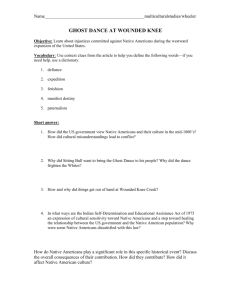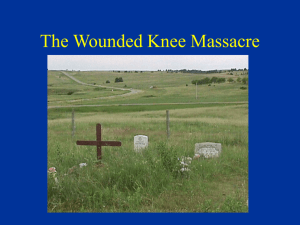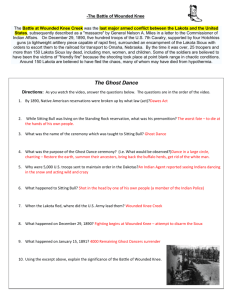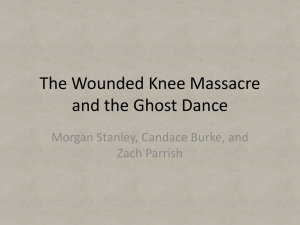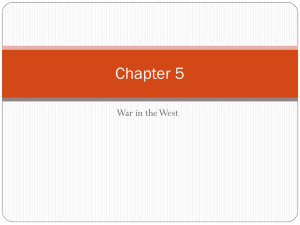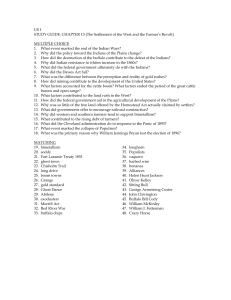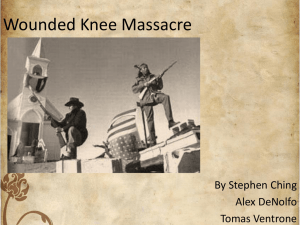Various Examples of Resistance to Imperialism
advertisement
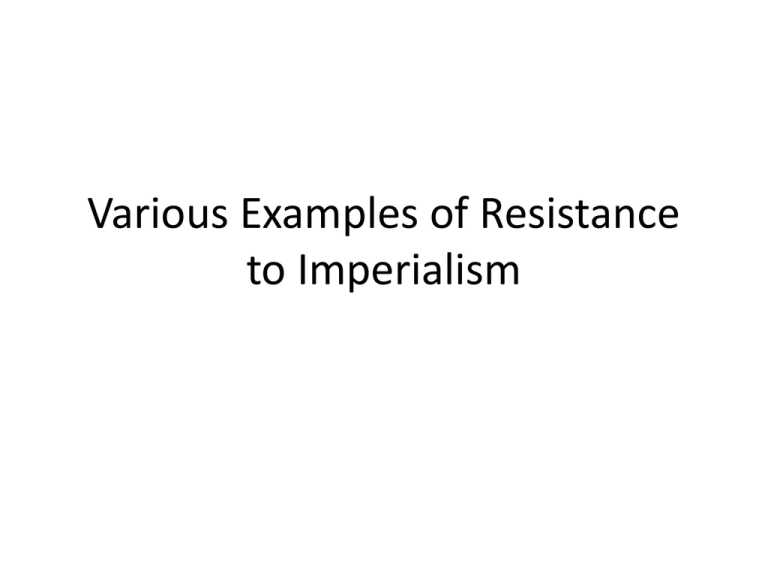
Various Examples of Resistance to Imperialism 1856-1857 Cattle Killing amongst the Xhosa in South Africa • One morning in 1856, a fifteen year old Xhosa girl named Nongqawuse went with another girl to scare birds from her uncle's crops in the fields by the sea at the Gxarha river mouth in the present day Wild Coast area of South Africa. When she returned she said that she had seen a man, who had told her that 'The whole community would rise from the dead ; that all cattle now living must be slaughtered'. The girls returned home and told their families what had happened but they were not believed. Later, however, when Nongqawuse described one of the men, her uncle Mhalakaza, himself a diviner, recognised the description as that of his dead brother, and became convinced she was telling the truth. Nonqawuse (on the left) Suicide or Resistance? • As a result, between April 1856 and June 1857, the various sections of the Xhosa people of the Eastern Cape and the Transkei slaughtered almost all their enormous stocks of cattle and deliberately killed their crops. This apocalyptic event, rather than being some kind of 'mass suicide's described by early colonial historians, was actually the earliest example of a mass 'passive resistance' movement in South Africa. The themes and symbols of the Cattle-Killing can be found in the various resistance movements of South Africa right into the modern era. The Prophesy • Nongqawuse and Mhalakaza said that those who had appeared to them were the spirits of their dead ancestors, who had come back to life in order to bring the Xhosa nation back to its former glory and to 'render the Xhosa the assistance they required in order to drive the white man out of the land'. • The cattle, said Nongqawuse, were at present in underground caverns waiting to arise and start a new world for the purified Xhosa people. On the day of their coming, she promised, 'the blind would see, the deaf would hear, cripples would walk, and the whole Xhosa nation would arise from the dead' and begin a golden age without disease, death or misfortune. Xhosa resistance to the movement • Many refused to believe the truth of the prophecies and refused to waste their corn and neglect their gardens. By the end of 1856, so many cattle had been killed that the adherents of the movement had gone too far to turn back. Searching for a reason why the dead had not been resurrected as the prophecies promised, they blamed the 'selfish' actions of the 'Unbelievers' in preserving their cattle. Colonial Response to the Cattle Killing Movement • The estimated figure of those who died as result of the cattle-killing stands at 40,000. In addition, the Governor of the Cape instigated a massive program of labor 'recruitment' which led to thousands of Xhosa being transported across the border into Cape Colony. Magistrates were instructed only to give food and relief to those who were willing to be contracted for labor in the colony. Those who agreed were obliged to sign a term of agreement whereby they expressed their willingness to work anywhere in Cape Colony for any wage that was offered. Sepoy Uprising 1857 • India, 1857 • Mutiny or 1st War of Indian Independence? • 2 competing narratives with different perspectives: British vs. Indian • Began with the British East India COMPANY seizing lands in India Sepoy Soldiers • Hindu or Muslim Indians who were employed by the British East India Company Lee-Enfield Rifle • .303 caliber ammunition that needed to be manually loaded • To load you had to bite the cartridge, which was sealed with beef or pork fat (tallow) • This proved to be a problem because that violated religious dietary restrictions of Muslims and Hindus. Sepoy War, 1857 • The "unorganized peasants" of India fought one of the most powerful empires in the world to near defeat with limited resources and even more limited training. • Impact: British Empire stepped in to aid the British East India Company, and then took over administration of India • India= “Jewel in the Crown” of the British Empire. Ghost Dance: 1890’s • Millenarian Movement that swept through Native American communities in the Plains of the United States • By the 1880's the U.S. government had managed to confine almost all of the Indians on reservations, usually on land so poor that the white man could conceive of no use for it themselves. The rations and supplies that had been guaranteed them by the treaties were of poor quality, if they arrived at all. Graft and corruption were rampant in the Indian Bureau Wovoka and the Ghost Dance Movement • However, by 1890 conditions were so bad on the reservations, nationwide, with starvation conditions existing in many places, that the situation was ripe for a major movement to rise among the Indians. This movement found its origin in a Paiute Indian named Wovoka, who announced that he was the messiah come to earth to prepare the Indians for their salvation. Representatives from tribes all over the nation came to Nevada to meet with Wovoka and learn to dance the Ghost Dance and to sing Ghost Dance songs. Wovoka The Ghost Dance Prophesy: • Next spring, when the grass was high, the earth would be covered with new soil, burying all the white men. The new soil would be covered with sweet grass, running water and trees; the great herds of buffalo and wild horses would return. All Indians who danced the Ghost Dance would be taken up into the air and suspended there while the new earth was being laid down. Then they would be replaced there, with the ghosts of their ancestors, on the new earth. Only Indians would live there then. The Ghost Dance Followers: • This new religion was being taught at all of the Sioux reservations now. Big Foot's band, which consisted mostly of women who had lost their husbands and/or other male relatives in battles with Custer, Miles and Crook, would dance until they collapsed, hoping to guarantee the return of their dead warriors. • Kicking Bear assured him that, if the dancers wore their Ghost Dance shirts, painted with magic symbols, the soldiers bullets would not strike them. U.S. Government Response • As the number of people involved in the Ghost Dance movement increased, the panic and hysteria of the Indian agents increased with it. • The whites stumbled over each other in their attempts to quell this movement. Panicky messages about Indians dancing in the snow, wild and crazy, were sent to Washington. Sitting Bull The Assassination of Sitting Bull • On December 15, 43 Indian police surrounded Sitting Bull's cabin before dawn. Three miles away they were backed up by a squadron of cavalry. When Lieutenant Bull Head entered the cabin, Sitting Bull was asleep. Upon awakening, he agreed to come with the police and asked that his horse be saddled while he dressed. When they left the cabin, a large group of Ghost Dancers, much larger than the police force, had assembled and challenged the police. One dancer, Catch-the-Bear, pulled out a rifle and shot Lieutenant Bull Head in the side. In an attempt to shoot back at his assailant, Bull Head instead accidentally shot Sitting Bull. Then another policeman, Red Tomahawk, shot Sitting Bull in the head. Many Indian policemen died that day before the cavalry arrived to quell the fighting. Massacre at Wounded Knee, 1890 • After Sitting Bull's death, Big Foot feared for the safety of his band, which consisted in large part of widows of the Plains wars and their children. Big Foot himself had been placed on the list of "fomenters of disturbances," and his arrest had been ordered. The Next Morning… • In the morning a bugle call awakened the camp and the men were told to come to the center of the camp for a talk. After the talk they would move to Pine Ridge. Big Foot was brought out and seated before his tent. The older men of the band gathered around him. Hardtack was issued for breakfast. Then the Indians were informed that they would be disarmed. They stacked their guns in the center, but the soldiers were not satisfied. The soldiers went through the tents, bringing out bundles and tearing them open, throwing knives, axes, and tent stakes into the pile. Then they ordered searches of the individual warriors. The Indians became very angry but only one spoke out, the medicine man, Yellow Bird. He danced a few steps of the Ghost Dance and chanted in Sioux, telling the Indians that the bullets would not hurt them, they would go right by. Hotchkiss Guns used at Wounded Knee The Massacre at Wounded Knee, 1890 • The search found only two rifles, one brand new, belonging to a young man named Black Coyote. He raised it over his head and cried out that he had spent much money for the rifle and that it belonged to him. Black Coyote was deaf and therefore did not respond promptly to the demands of the soldiers. He would have been convinced to put it down by the Sioux, but that option was not possible. He was grabbed by the soldiers and spun around. Then a shot was heard; its source is not clear but it began the killing. The only arms the Indians had were what they could grab from the pile. When the Hotchkiss guns opened up, shrapnel shredded the lodges, killing men, women and children, indiscriminately. They tried to run but were shot down "like buffalo," women and children alike. The Aftermath • When the mass insanity of the soldiers ended, 153 dead were counted, including Big Foot; but many of the wounded had crawled off to die alone. One estimate place the final death toll at 350 Indian men, women and children. Twenty-five soldiers died and 39 were wounded, most by their own shrapnel and bullets. The wounded soldiers were started back to the Pine Ridge agency. Then a detail of soldiers went over the battlefield, gathering up any Indians that were still alive and placing them in wagons. As a blizzard was approaching, the dead were left where they had fallen. The wagons with the wounded arrived at Pine Ridge after dark. They contained only 4 Sioux men and 47 women and children. These people were left outside in wagons in the bitter cold while a search was made for housing for them. Finally the Episcopal mission was opened, the benches removed and hay scattered over the floor as bedding for the wounded Sioux. As they were brought in, those who were conscious could see the Christmas decorations hanging from the rafters. “Bury My Heart at Wounded Knee,” 1890 The Boxer Rebellion, 1900 • Boxer Rebellion (1900): Beginning in 1898, groups of peasants in northern China began to band together into a secret society known as I-ho ch'üan ("Righteous and Harmonious Fists"), called the "Boxers" by Western press. Members of the secret society practiced boxing and calisthenic rituals (hence the nickname, the "Boxers") which they believed would make them impervious to bullets. • At first, the Boxers wanted to destroy the Ch'ing dynasty (which had ruled China for over 250 years) and wanted to rid China of all foreign influence (which they considered a threat to Chinese culture). When the Empress Dowager backed the Boxers, the Boxers turned solely to ridding China of foreigners. Society of Harmonious Fists Rebellion against Qing Dynasty and “Foreign Devils” • By late 1899, bands of Boxers were massacring Christian missionaries and Chinese Christians. By May 1900, the Boxer Rebellion had come out of the countryside and was being waged in the capital of Peking (now Beijing). To help their fellow countrymen and to protect their interests in China, an international force of 2,100 American, British, Russian, French, Italian, and Japanese soldiers were sent to subdue the "rebellion." • On June 18, 1900, the Empress Dowager ordered all foreigners to be killed. Several foreign ministers and their families were killed before the international force could protect them. On August 14, 1900, the international force took Peking and subdued the rebellion. Empress Dowager Cixi Legation Building in Peking • The Siege of the Legation lasted for 55 days until an international force marching from Tientsin on the coast managed to relieve them. 66 Europeans had been killed in this time and 150 had been wounded. This type of treatment was unforgivable from a European point of view. America had also been shocked by the treatment of the Europeans. Maji Maji Rebellion (1905-1907) • Background: Uprising by several indigenous African communities in Tanzania against the German colonial rule in response to a German plan to force the Africans to grow cotton for export. • Key: Interethnic opposition to German Colonial Rule Maji Maji Warriors Maji Maji Rebellion (1905-1907) • Leader of the rebellion was Bokero (Kinjikitile Ngwale) who was believed to be possessed by a snake spirit. • Maji was a name for the medicine (elixir of water and castor oil) that was supposed to give the believers immunity to German bullets. • African warriors armed with war medicine, cap guns and spears began attacking German garrisons. Maji Maji Prisoners of War Maji Maji Rebellion (1905-1907) • Although outnumbered, Germans had the advantage of the machine gun which they used liberally against the Africans • Bokero was killed and replaced with another mystic. • Germans retaliated with a scorched earth policy that led to famine • Germans maintained control through WWI- then lost Tanzania to the British • Despite defeat, important point of pride for the African peoples in Tanzania.
